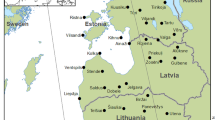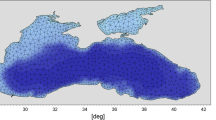Abstract
The Mediterranean Sea is subject to significant and variable climatic changes. In this work, an analysis of a 39-year-long wave time series was performed in order to identify ongoing trends of two synthetic parameters, significant wave height and energy period, along the coasts of the Calabria region (southern Italy). First, wave data were acquired from the global atmospheric reanalysis data set European Centre for Medium-Range Weather Forecasts Re-Analysis Interim (ERA-Interim) and were processed in order to check their quality. Then, the data were subject to a geographical transposition method in order to transfer the wave parameters at a representative water depth of 100 m. Finally, trend analyses have been performed using the nonparametric Mann–Kendall (MK) test and a graphical technique, the Innovative Trend Analysis (ITA), which allows to identify trends in the several values of a series. At annual and seasonal scale, the results deduced from MK test mainly evidenced a slight or null increase of the significant wave height and a relevant increase of the energy period, influencing the magnitude of the wave power by the occurrence of longer waves. Moreover, the ITA method highlights a general increase in the highest values of the involved wave parameters. For the studied area, these aspects have a significant impact on the retreating of the beaches and on the future field installations of wave energy converters (WECs) for electricity purposes.









Similar content being viewed by others
References
Aarnes OJ, Abdalla S, Bidlot JR, Breivik O (2015) Marine wind and wave height trends at different ERA-Interim forecast ranges. J Clim 28:819–837
Algieri Ferraro D, Aristodemo F, Veltri P (2016) Wave energy resources along Calabrian coasts (Italy). In: Proc. of 35th International Conference on Coastal Engineering, Antalya, Turkey, pp 1–12. https://doi.org/10.9753/icce.v35.waves.5
Allan J, Komar P (2000) Are ocean wave heights increasing in the eastern North Pacific? EOS Trans AGU 47:566–567
Appendini CM, Torres-Freyermuth A, Salles P, López-González J, Mendoza ET (2014) Wave climate and trends for the Gulf of Mexico: a 30-yr wave hindcast. J Clim 27:1619–1632
Aristodemo F, Algieri Ferraro D (2018) Feasibility of WEC installations for domestic and public electrical supplies: a case study off the Calabrian coast. Renew Energy 121:261–285
Ay M, Kisi O (2015) Investigation of trend analysis of monthly total precipitation by an innovative method. Theor Appl Climatol 120:617–629
Babarit A, Hals J, Muliawan MJ, Kurniawan A, Moan T, Krokstad J (2012) Numerical benchmarking study of a selection of wave energy converters. Renew Energy 41:44–63
Bacon S, Carter DJT (1991) Wave climate changes in the North Atlantic and North Sea. Int J Climatol 11:545–558
Bacon S, Carter DJT (1993) A connection between mean wave height and atmospheric pressure gradient in the North Atlantic. Int J Climatol 13:423–436
Bertin X, Prouteau E, Letetrel C (2013) A significant increase in wave height in the North Atlantic Ocean over the 20th century. Glob Planet Chang 106:77–83
Besio G, Mentaschi L, Mazzino A (2016) Wave energy resource assessment in the Mediterranean Sea on the basis of a 35-year hindcast. Energy 94:50–63
Bouws E, Jannink D, Komen GJ (1996) The increasing wave height in the North Atlantic Ocean. Bull Am Meteor Soc 77:2275–2277
Bromirski PD, Cayan DR, Helly J, Wittmann P (2013) Wave power variability and trends across the North Pacific. J Geophys Res Oceans 118:6329–6348
Caloiero T (2018) SPI trend analysis of New Zealand applying the ITA technique. Geosciences 8:101
Caloiero T, Coscarelli R, Ferrari E (2018) Application of the innovative trend analysis method for the trend analysis of rainfall anomalies in southern Italy. Water Resour Manag 32:4971–4983
Camus P, Losada IJ, Izaguirre C, Espejo A, Menéndez M, Pérez J (2017) Statistical wave climate projections for coastal impact assessments. Earth’s Future 5:918–933
Carter DJT, Draper L (1988) Has the north-east Atlantic become rougher? Nature 332:494
Coastal Engineering Research Center (1984) Shore protection manual. Dept. of the Army, Waterways Experiment Station, Corps of Engineers, Coastal Engineering Research Center, Washington
Contini P, De Girolamo P (1988) Impatto morfologico di opere a mare: casi di studio. In: Proc. of the VIII Convegno AIOM, Lerici (in Italian)
Cuadra L, Salcedo-Sanz S, Nieto-Borge JC, Alexandre E, Rodríguez G (2016) Computational intelligence in wave energy: comprehensive review and case study. Renew Sust Energ Rev 58:1223–1246
Dodet G, Bertin X, Taborda R (2010) Wave climate variability in the north-east Atlantic Ocean over the last six decades. Ocean Model 31:120–131
Gower JFR (2002) Temperature, wind, and wave climatologies, and trends from marine meteorological buoys in the northeast Pacific. J Clim 15:3709–3718
Gulev SK, Hasse L (1999) Changes of wind waves in the North Atlantic over the last 30 years. Int J Climatol 19:1091–1117
Haktanir T, Citakoglu H (2014) Trend, independence, stationarity, and homogeneity tests on maximum rainfall series of standard durations recorded in Turkey. J Hydrol Eng 19:9
Hithin NK, Sanil Kumar V, Shanas PR (2015) Trends of wave height and period in the Central Arabian Sea from 1996 to 2012: a study based on satellite altimeter data. Ocean Eng 108:416–425
IPCC (2013) Summary for policymakers. Fifth Assessment Report of the Intergovernmental Panel on Climate Change. Cambridge University Press, Cambridge and New York
Irish JL, Frey AE, Rosati JD, Olivera F, Dunkin LM, Kaihatu JM, Ferreira CM, Edge BL (2010) Potential implications of global warming and barrier island degradation on future hurricane inundation, property damages, and population impacted. Ocean Coast Manag 53:645–657
Izaguirre C, Méndez FJ, Espejo A, Losada IJ, Reguero BG (2013) Extreme wave climate changes in Central–South America. Clim Chang 119:277–290
Kaliraj S, Chandrasekar N, Magesh NS (2004) Impacts of wave energy and littoral currents on shoreline erosion/ accretion along the south-west coast of Kanyakumari, Tamil Nadu using DSAS and geospatial technology. Environ Earth Sci 71:4523–4542
Kendall MG (1962) Rank correlation methods. Hafner Publishing Company, New York
Kisi O (2015) An innovative method for trend analysis of monthly pan evaporations. J Hydrol 527:1123–1129
Kisi O, Ay M (2014) Comparison of Mann–Kendall and innovative trend method for water quality parameters of the Kizilirmak River, Turkey. J Hydrol 513:362–375
Kumar VS, Joseph J, Amrutha MM, Jena BK, Sivakholundu KM, Dubhashi KK (2018) Seasonal and interannual changes of significant wave height in shelf seas around India during 1998–2012 based on wave hindcast. Ocean Eng 151:127–140
Liberti L, Sannino G, Carillo A (2013) Wave energy resource assessment in the Mediterranean, the Italian perspective. Renew Energy 50:938–949
Lionello P, Sanna A (2005) Mediterranean wave climate variability and its links with NAO and Indian Monsoon. Clim Dyn 25:611–623
Mann HB (1945) Nonparametric tests against trend. Econometrica 13:245–259
Martínez-Austria PF, Bandala ER, Patiño-Gómez C (2015) Temperature and heat wave trends in northwest Mexico. Phys Chem Earth 91:20–26
Martucci G, Carniel S, Chiggiato J, Sclavo M, Lionello P, Galati MB (2010) Statistical trend analysis and extreme distribution of significant wave height from 1958 to 1999 - an application to the Italian seas. Ocean Sci 6:525–538
Miche M (1951) Le Pouvoir Reflechissant des Ouvrages Maritimes Exposes a l’Action de la Houle. Ann des Ponts Chaussess 12:285–319
Mitchell TD, Jones PD (2005) An improved method of constructing a database of monthly climate observations and associated high-resolution grids. Int J Climatol 25:693–712
Piscopia R, Inghilesi R, Panizzo A, Corsini S, Franco L (2002) Analysis 599 of 12-year wave measurements by the Italian Wave Network. In: Proc. of 28th International Conference on Coastal Engineering, Cardiff, Wales, pp 1–13. https://doi.org/10.1142/9789812791306_0011
Pomaro A, Cavaleri L, Lionello P (2017) Climatology and trends of the Adriatic Sea wind waves: analysis of a 37–year long instrumental data set. Int J Climatol 37:4237–4250
Reguero B, Méndez F, Losada I (2013) Variability of multivariate wave climate in Latin America and the Caribbean. Glob Planet Chang 100:70–84
Ruggiero P, Komar P, Allan J (2010) Increasing wave heights and extreme value projections the wave climate of the US Pacific Northwest. Coast Eng 57:539–552
Sartini L, Mentaschi L, Besio G (2015) Comparing different extreme wave analysis models for wave climate assessment along the Italian coast. Coast Eng 100:37–47
Saville T, Asce M, McClendon EW, Cochran AL, Asce F (1962) Freeboard allowances for waves in inland reservoirs. J Waterway Div-Asce 88:93–124
Schneider U, Becker A, Finger P, Meyer-Christoffer A, Ziese M (2018) GPCC full data monthly product version 2018 at 0.5: monthly land-surface precipitation from rain-gauges built on GTS-based and historical data. Deutscher Wetterdienst, Offenbach am Main. https://doi.org/10.5676/DWD_GPCC/FD_M_V2018_050
Semedo A, Suselj K, Rutgersson A, Sterl A (2011) A global view on the wind sea and swell climate and variability from ERA-40. J Clim 24:1461–1479
Şen Z (2012) An innovative trend analysis methodology. J Hydrol Eng 17:1042–1046
Şen Z (2014) Trend identification simulation and application. J Hydrol Eng 19:635–642
Shanas PR, Kumar VS (2015) Trends in surface wind speed and significant wave height as revealed by ERA–Interim wind wave hindcast in the Central Bay of Bengal. Int J Climatol 35:2654–2663
Ulazia A, Penalba M, Ibarra–Berastegui G, Ringwood J, Saénz J (2017) Wave energy trends over the Bay of Biscay and the consequences for wave energy converters. Energy 141:624–634
UNEP (2006) Marine and coastal ecosystems and human well-being: a synthesis report based on the findings of the Millennium Ecosystem Assessment. UNEP-WCMC, Cambridge
Vanem E, Walker SE (2013) Identifying trends in the ocean wave climate by time series analyses of significant wave height data. Ocean Eng 61:148–160
Vicinanza D, Contestabile P, Ferrante V (2013) Wave energy potential in the north-west of Sardinia. Renew Energy 50:506–521
Wang XL, Swail VR (2002) Trends of Atlantic wave extremes as simulated in a 40-yr wave hindcast using kinematically reanalyzed wind fields. J Clim 15:1020–1035
Wu L, Wang XL, Feng Y (2014) Historical wave height trends in the South and East China seas, 1911-2010. J Geophys Res 119:4399–4409
Young IR, Zieger S, Babanin AV (2011) Global trends in wind speed and wave height. Science 332:451–455
Zikra M, Ashfar P, Mukhtasor (2016) Analysis of wave climate variations based on ERA-Interim reanalysis data from 1980 to 2014 to support wave energy assessment in Indonesia. ARPN J Eng Appl Sci 11:879–884
Zodiatis G, Galanis G, Nikolaidis A, Kalogeri C, Hayes D, Georgiou GC, Chu PC, Kallos G (2014) Wave energy potential in the Eastern Mediterranean Levantine Basin. An integrated 10-year study. Renew Energy 69:311–323
Acknowledgements
The ECMWF data were made available by the Meteorological Archival and Retrieval System (MARS) archive under the permission of the Italian Air Force.
Author information
Authors and Affiliations
Corresponding author
Additional information
Publisher’s note
Springer Nature remains neutral with regard to jurisdictional claims in published maps and institutional affiliations.
Rights and permissions
About this article
Cite this article
Caloiero, T., Aristodemo, F. & Algieri Ferraro, D. Trend analysis of significant wave height and energy period in southern Italy. Theor Appl Climatol 138, 917–930 (2019). https://doi.org/10.1007/s00704-019-02879-9
Received:
Accepted:
Published:
Issue Date:
DOI: https://doi.org/10.1007/s00704-019-02879-9




